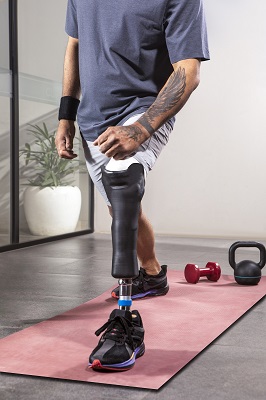Five Most Common Misconceptions About Prosthetic Legs
Missing a limb can be a traumatic experience for anybody but having to live with a heavy, uncomfortable artificial limb that doesnt fit well can also be very painful for the amputee. Prosthetic limbs, particularly artificial legs, need to fit into the amputated leg to the tee. They should have sockets that replicate natural functionality and should be lightweight, all of which is possible today if amputees have a better understanding and choose the right clinic. However, we do often hear of common misconceptions associated with prosthetic legs Mr Yutaka Tokushims, CEO, Instalimb debunks these myths in this article here: Advanced Quality Products with Personalised Solutions by Instalimb Prosthetic legs are uncomfortable for the amputee A classic myth. The best prostheses are those that allow the patient to do sports, dance, motorcycle, travel, hike and work while wearing them. They are not supposed to hurt amputees. Every amputee needs to educate themselves to make the right choice to find a prosthesis that is meticulously crafted to perfection ensured by the latest technology and highly skilled certified prosthetists. Once you use an artificial leg that is your perfect fit, you will neither find it painful, heavy nor uncomfortable. It just becomes a part of your body. High-quality means imported prosthetic components Untrue. People frequently assume that a device is good only when it contains high-quality components that have been imported from other countries. That is not true at all. When it comes to prosthetics and its quality, the most integral part is the socket. An artificial leg that consists of expensive foreign components can easily hurt you if the socket is no good. Test-fitting is not necessary Very wrong. Test fitting is extremely important to make sure an artificial limb fits to perfection. If clinics follow the international standard, no prosthetists will skip the process of test fitting no matter how many years they have been in the field. Be aware of statements such as "Our prosthetists are too good to do a test fitting" - a classic alert to doubt their quality. Rather, clinics that have confidence in their socket quality, sometimes provide you a test fitting for free, so that amputees can know the difference before making a financial commitment. An artificial limb is permanently fitted Not true. As the stump gets changed over years because your residual limb use has become far less than it used to be before surgery. In more technical terms, a reduction in stump size or shrinkage occurs due to postoperative muscle atrophy, that is your muscle becomes inactive and reduces in size overall. This reduction is stump muscle size can continue over lifetime as a slow process. Hence, the device will need to be replaced once in every 3-5 years depending on usage. Good prosthetic is always expensive Not at all. Even if an amputee invests a lot of money to get an expensive artificial leg, it is so easy to get a painful device in return. If he or she did not make the right choice while deciding the right prosthetist and the clinic. To avoid this nightmare, visit several clinics for consultations and see what technology they use. Sometimes, the reason for high cost can be due to a lack of efficient production process empowered by the latest technology or expensive and over-performing components that a patient does not really need. High cost is not equal to high comfort! Instalimb, the world's first 3D-printed prosthetic-legs manufacturer based in Japan, recently entered the Indian market and designs lower limb prosthetic solutions that reinvent the whole prosthetic leg industry to enable the amputees to increase their quality of life.

Missing a limb can be a traumatic experience for anybody but having to live with a heavy, uncomfortable artificial limb that doesnt fit well can also be very painful for the amputee. Prosthetic limbs, particularly artificial legs, need to fit into the amputated leg to the tee. They should have sockets that replicate natural functionality and should be lightweight, all of which is possible today if amputees have a better understanding and choose the right clinic. However, we do often hear of common misconceptions associated with prosthetic legs Mr Yutaka Tokushims, CEO, Instalimb debunks these myths in this article here:
 |
Advanced Quality Products with Personalised Solutions by Instalimb
Prosthetic legs are uncomfortable for the amputee
A classic myth. The best prostheses are those that allow the patient to do sports, dance, motorcycle, travel, hike and work while wearing them. They are not supposed to hurt amputees. Every amputee needs to educate themselves to make the right choice to find a prosthesis that is meticulously crafted to perfection ensured by the latest technology and highly skilled certified prosthetists. Once you use an artificial leg that is your perfect fit, you will neither find it painful, heavy nor uncomfortable. It just becomes a part of your body.
High-quality means imported prosthetic components
Untrue. People frequently assume that a device is good only when it contains high-quality components that have been imported from other countries. That is not true at all. When it comes to prosthetics and its quality, the most integral part is the socket. An artificial leg that consists of expensive foreign components can easily hurt you if the socket is no good.
Test-fitting is not necessary
Very wrong. Test fitting is extremely important to make sure an artificial limb fits to perfection. If clinics follow the international standard, no prosthetists will skip the process of test fitting no matter how many years they have been in the field. Be aware of statements such as "Our prosthetists are too good to do a test fitting" - a classic alert to doubt their quality. Rather, clinics that have confidence in their socket quality, sometimes provide you a test fitting for free, so that amputees can know the difference before making a financial commitment.
An artificial limb is permanently fitted
Not true. As the stump gets changed over years because your residual limb use has become far less than it used to be before surgery. In more technical terms, a reduction in stump size or shrinkage occurs due to postoperative muscle atrophy, that is your muscle becomes inactive and reduces in size overall. This reduction is stump muscle size can continue over lifetime as a slow process. Hence, the device will need to be replaced once in every 3-5 years depending on usage.
Good prosthetic is always expensive
Not at all. Even if an amputee invests a lot of money to get an expensive artificial leg, it is so easy to get a painful device in return. If he or she did not make the right choice while deciding the right prosthetist and the clinic. To avoid this nightmare, visit several clinics for consultations and see what technology they use. Sometimes, the reason for high cost can be due to a lack of efficient production process empowered by the latest technology or expensive and over-performing components that a patient does not really need. High cost is not equal to high comfort!
Instalimb, the world's first 3D-printed prosthetic-legs manufacturer based in Japan, recently entered the Indian market and designs lower limb prosthetic solutions that reinvent the whole prosthetic leg industry to enable the amputees to increase their quality of life.
![]()































































































